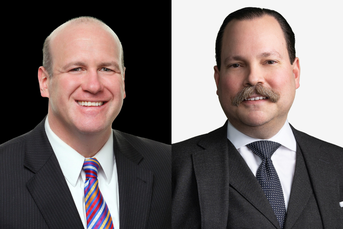Revenue split the same for advisers and reps: Survey
New research shows that investment advisers are just as dependent on commissions as wirehouse reps are. Why is this?
As more firms combine a registered investment adviser with a broker-dealer arm, they are generating about as much income from commissions as they are from asset-based fees. That’s making their revenue streams similar to those of big brokerage firms, according to a recent report.
“Commissions-based revenue and recurring [assets under management]-based fee revenue each comprise between 40% and 47% of total revenue for all RIA practices and large wirehouse practices, indicating that their business models are not all that different,” according to a March 12 report from Aite Group LLC.
The organization conducted an online survey of 534 financial advisers in March 2012. It arranged respondents in two categories — small practices with AUM between $30 million and $99 million, and large practices, with AUM between $100 million and $1 billion.
The study shows that wirehouse advisers with smaller practices garnered 58% of their total revenue from commissions, while 47% of small-practice RIAs did the same. For large practices in each category, commissions comprised about 40% of total revenue.
“The roughly even allocation between commission and recurring AUM-based fee revenue for large-practice RIA-affiliated advisors suggests that commission revenue is an important revenue source for RIA practices of all sizes,” the report said.
The findings illustrate the growing trend of RIAs who operate as hybrids, also functioning as brokers, according to Bill Butterfield, an Aite research analyst and co-author of the report.
“The reality is that a lot of advisers are dually registered,” Mr. Butterfield said. “They’re doing commission-based business and fee-based business, as well. The way that advisers conduct business is not as clear-cut based on channel affiliation as it was 10 or 15 years ago.”
Of the RIAs who responded to the survey, 60% to 65% were dually registered, while 80% to 85% of the broker participants were dually registered.
One observer criticized the study for mixing apples and oranges by putting all investment advisers in one category without distinguishing between hybrids and pure RIAs.
“It’s grossly confusing and misleading to characterize them all as RIAs,” said Michael Kitces, a partner and director of research at Pinnacle Advisory Group Inc. “RIAs aren’t taking commissions. RIAs who also have a broker-dealer license are separately getting commissions for the brokerage business they conduct.”
The increasing trend of RIAs dually registering as brokers has caught the attention of the Securities and Exchange Commission, which is concerned about potential conflicts of interest. The SEC has targeted them as an examination priority this year.
The hybrid model is not undermining one of the RIAs’ major marketing points — that they are bound by a fiduciary duty to put the client’s interests ahead of their own, according to Mr. Kitces. Brokers have to meet a less-stringent standard when selling investment products. They can earn commissions as long as the product is suitable for the client.
“Hybrids, with a wider range of business models, products and compensation methods, have the tools to work with a wider range of the public,” said Mr. Kitces, author of the Nerd’s Eye View blog on the financial planning sector. “Fiduciary duty and commissions do not have to be mutually exclusive.”
But Knut Rostad, president of the Institute for the Fiduciary Standard, has misgivings about the confluence of the investment adviser and broker business models.
“It’s more important than ever to make sure [advisers’] practices and procedures are truly upholding the fiduciary standard,” Mr. Rostad said. “As the lines blur, by definition there’s going to be more circumstances where there are shades of gray, rather than the sharper distinctions that separate the sales broker from the fiduciary adviser.”
The wirehouses — Bank of America Merrill Lynch, Morgan Stanley, Wells Fargo Advisors and UBS — control more than 35% of U.S. assets under management, according to the Aite report. The RIA channel, with 15,000 firms, controls about 12%.
Learn more about reprints and licensing for this article.








